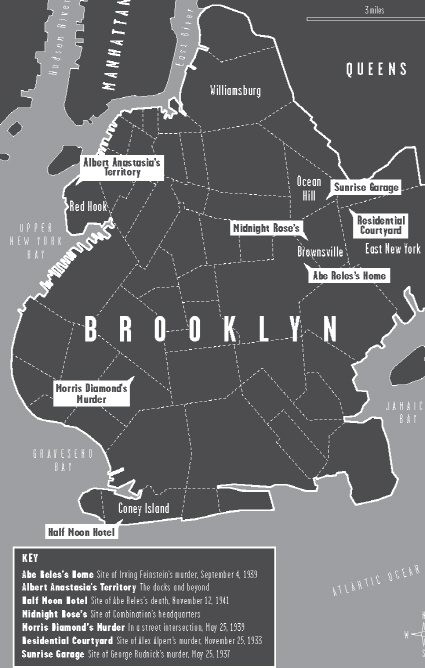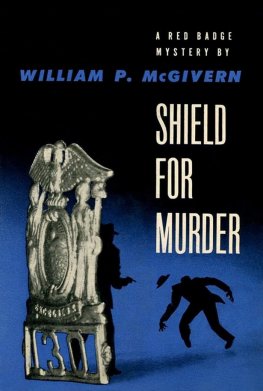
STERLING and the distinctive Sterling logo are registered trademarks of Sterling Publishing Co., Inc.
Library of Congress Cataloging-in-Publication Data
Elmaleh, Edmund.
The canary sang but couldn't fly: the fatal fall of Abe Reles, the mobster
who shattered Murder, Inc.'s code of silence / by Edmund Elmaleh.
p. cm.
Includes bibliographical references and index.
ISBN 978-1-4027-6113-3
1. Reles, Abe, 1906-1941. 2. CriminalsUnited StatesBiography.
3. MafiaUnited StatesHistory20th century. I. Title.
HV6446.E45 2009
364.1092dc22
[B]
2008041353
2 4 6 8 10 9 7 5 3 1
Published by Sterling Publishing Co., Inc.
387 Park Avenue South, New York, NY 10016
2009 by Edmund Elmaleh
Map of Brooklyn 2009 by Alan Kikuchi
Jacket Design: Elizabeth Mihaltse
Cover Photograph: Bettmann/CORBIS
All rights reserved
Sterling eBook ISBN: 978-1-4549-0262-1
For information about custom editions, special sales, premium and corporate purchases, please contact Sterling Special Sales Department at 800-805-5489 or specialsales@sterlingpublishing.com.
Table of Contents
For Kathi Kapell, who means everything to me
and
in loving memory of Elaine, Lorraine, and Eliott
Never rat on your friends, and always keep your mouth shut.
A mobsters advice to his young protg,
from the movie Goodfellas
You dont know those bastards like I do.
Anywhere in the world theyd find me, if I was on the outside.
Anywhere in the worldand theyd knock me off!
Abe Reles on the Mobs determination to assassinate him
I never met anybody who thought Abe went out
that window because he wanted to.
Mob informer Joe Valachi on Reless death

Chapter 1
Kid Twist and the Combination
Abe Reles was a living, breathing, nightmare.
Just the look in his eyes was enough to fill anyone with fear.
His eyes were shiny agates, hard and piercing, recalled Burton Turkus, an assistant district attorney who came to know him well. He had a round face, thick lips, a flat nose, and small ears stuck close to his kinky hair. His jowls were heavy, his five oclock shadow ever present, his voice gravelly from chain-smoking. His hirsute arms dangled to his knees, completing a generally gorilla-like figure. Even if you could get past his unsightly mug, there was one thing that you could never put out of your mind: his hands.
They were strong; they strangled men, Turkus remembered. Where ordinary fingers start to taper at the ends, Reless became spatulate. They reminded you of a set of hammers, hung at the end of the arm.
As far as Turkus was concerned, you didnt even have to know Abe Reles to loathe him. If a total stranger walked up to Reles and, without a word, bashed him in the face, I could understand it. That was the reaction you got from one look at him.
Not that anybody in his right mind would have tried. While not physically imposinghe wasnt a big man at five foot five and 160 poundsReles was tough, menacing, and extremely violent. A stonecold killer, he once strangled a man to death as his own mother-in-law slept just a few feet away. (He did, however, wake the elderly woman long enough to ask where he could find the rope he needed to choke the life out of his victim.) During his criminal career, which began when Reles was only a teenager, he was arrested more than forty times, including six times on murder charges. But each homicide rap was thrown out due to lack of evidence, a sign that Reles had greased the palm of some crooked judge. If he found himself short of cash for bribes, Reles had an effective Plan B: threatening or killing the witnesses against him.
Reles had a volcanic temper, and he was capable of unimaginable brutality. A police officer who knew him well recalled the time that he tore the head off a kitten right in his own living room by sheer force with his fingers. The kitten had climbed on the settee and he didnt like it, and he took the kitten and tore the head off and threw it out. Another time, Reles grew impatient with a garage attendant who was working too slowly to suit himso he smashed a bottle over the young mans head, fracturing his skull. Once, when two young women spurned his lewd advances, he jumped into his car and tried to run them over; the women survived by ducking into an alley at the last second. Yes, Abe Reles was a real prince.
As a young man, he revered Max Zweibach, a lieutenant in the Lower East Side gang of Monk Eastman. In 1904, when Eastman went to prison for shooting at a Pinkerton detective during a bank holdup, Zweibach seized control of the gang. His intricate schemes for outsmarting his rivals earned him the moniker Kid Twist. Zweibach led the gangster life until May 1908, when he and his bodyguard, a circus strongman known as Cyclone Lewis, were gunned down outside a Coney Island bar. The killer, Louis Louie the Lump Pioggi, allegedly acted out of jealousyhe and Zweibach were in love with the same womanbut Pioggis membership in a rival gang suggests that the murder may not have been entirely a crime of passion.

Abe Kid Twist Reles. [Corbis]
Reles adopted Zweibachs nickname, Kid Twist, as his own. (Contrary to much that has been written, Reles was not given the nickname because of a fondness for licorice twist candy or a preference for strangling his victims.) Though Reles now had Zweibachs nickname, he did not possess an ounce of his idols finesse; rather, he was egotistical, crude, and miserly. With an inflated view of himself, Reles believed that he could outwit cops, lawyers, judgesyou name it. But his loud attire and coarse speech (which was littered with dese and dose) made a joke out of any stabs he made at appearing suave. And his penny-pinching was legendary among his cadre of crooks.
He was reluctant to pay and made no bones about it, one of them remembered. Reles enjoyed forcing his compatriots to pony up for everything while he flashed large wads of cash under their noses. Its safe to say that even those closest to Reles hated his guts.

The future menace to society was born in Manhattan on May 10, 1906, to Sam Reles and Rose Schulman, Jewish immigrants from Austria. Of the nearly two million Jews who migrated to the United States from Eastern Europe during the final decade of the nineteenth century and the first two decades of the twentieth, most settled in the foul, claustrophobic tenements of Manhattans Lower East Side. The Reles familys experience was no different. It was a far cry from the Golden Land (Die Goldene Medina, as it is expressed in Yiddish) the immigrants had envisioned as they crossed the ocean in the bowels of transatlantic liners. Once on American soil, any hopeful thoughts they still held dear were snuffed out by the realities of life. Winter forced families to sleep on the floor to absorb the warmth of their ramshackle kitchen stoves; the most basic privacy was nonexistent, and infectious diseases stole lives indiscriminately. Work, such as it existed, was a dismal euphemism for grinding poverty. It was enough to drive Sam Reles to distraction.
And then, a glimmer of hope. The opening of the Williamsburg Bridgewhich connected Manhattan with Brooklyn in 1903as well as other advances in public transportation came in time to relieve the Lower East Side. As a result, Brownsville, a community in northeast Brooklyn, became for large numbers their new home in the Golden Land. Whats more, as the Brooklyn historian Alter F. Landesman has written, the rapid rise of Brownsville was not due to the discovery of any one commodity, as was the case in boomtowns elsewhere in America. In Brownsville, tailors were the original pioneers; sewing machines, flat irons, scissors, needles, and thimblesthese were the foundation materials upon which the community was built.
Next page













